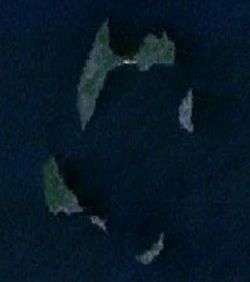Manitou Islands (Lake Nipissing)


The Manitou Islands are a series of small islands in Lake Nipissing, in Nipissing District, Ontario, Canada. The islands form a circle and lie 10 kilometres (6 mi) southwest of North Bay.
History
Samuel de Champlain visited the islands in 1613 and called them "pretty".[1] Fur traders found the island a handy resting spot, and often would camp overnight. Today the islands' sand beaches continue to be a popular resting and recreation spot for many boaters.
Lime was quarried on the islands in the 1880s when the Canadian Pacific Railway was built, and a lime kiln was operated to create lime for mortar.[1] Great Manitou Island, the largest of the islands, once held a dance hall and hotel, but it burned to the ground.[2] Uranium mining was conducted on Newman Island in the 1950s.[3]
Local legend says that the island is haunted by the Nipissing people who died of starvation after battling the Iroquois and being forced to flee the islands.[4]
Geography
The total area of the islands is 100 hectares (247 acres), and the total perimeter is 5 kilometres (3.1 mi). The five islands are:
- Great Manitou Island 46°16′41″N 79°34′34″W / 46.27806°N 79.57611°W
- Little Manitou Island 46°15′32″N 79°35′17″W / 46.25889°N 79.58806°W
- Calder Island 46°16′14″N 79°33′38″W / 46.27056°N 79.56056°W
- Rankin Island 46°15′00″N 79°34′03″W / 46.25000°N 79.56750°W
- Newman Island 46°15′17″N 79°34′45″W / 46.25472°N 79.57917°W
Provincial park
Today the islands are protected as Manitou Islands Provincial Park.[5]
Geology
The Manitou Islands lie inside the Ottawa-Bonnechere Graben and are part of an eroded volcanic pipe,[6] leaving the multiple islands. The volcanic pipe formed by the violent, supersonic eruption of a deep-origin volcano. These volcanoes originate at least three times as deep as most other volcanoes, and the resulting magma that is pushed toward the surface is high in magnesium and volatile compounds such as water and carbon dioxide. As the body of magma rises toward the surface, the volatile compounds transform to gaseous phase as pressure is reduced with decreasing depth. This sudden expansion propels the magma upward at rapid speeds, resulting in a shallow supersonic eruption.
The Manitou Islands contain the uncommon rock types of fenite and syenite. Minerals found associated with these rocks include: pyroxenites, amphibole, apatite, biotite, calcite, magnetite, monazite, nepheline, pyrite, pyrochlore, pyroxene and quartz.[7]
The nearby Callander Bay is also a volcanic pipe.
See also
References
- 1 2 Mackey, Doug (2004-06-18). "The aboriginal connection to the Manitous goes back centuries". Heritage Perspectives. Past Forward Heritage Limited. Retrieved 2009-06-08.
- ↑ Mackey, Doug (2004-05-21). "The Manitou Island Provincial Nature Preserve". Heritage Perspectives. Past Forward Heritage Limited. Retrieved 2009-06-08.
- ↑ Mackey, Doug (2004-06-25). "Mining on the Manitous…a thing of the past". Heritage Perspectives. Past Forward Heritage Limited. Retrieved 2009-06-08.
- ↑ Trembley, Marla. "The Manitou Islands of Lake Nipissing". Retrieved 2015-06-28.
- ↑ "Manitou Islands". Ontario Parks. 2008-07-03. Retrieved 2009-06-08.
- ↑ "Background Geology of the North Bay area". Archived from the original on 2007-12-20. Retrieved 2007-09-24.
- ↑ "Other localities - Canada". Retrieved 2007-09-28. Site information taken from Woolley, Alan R (1987). Alkaline rocks and carbonatites of the world. Part 1, North and South America. London: British Museum (Natural History). ISBN 978-0-565-00971-7. OCLC 220114352.
- "Topographic Map sheets 31L4, 31L5". Atlas of Canada. Natural Resources Canada. 2006-02-06. Retrieved 2009-06-08.
Coordinates: 46°16′10″N 79°33′38″W / 46.26944°N 79.56056°W